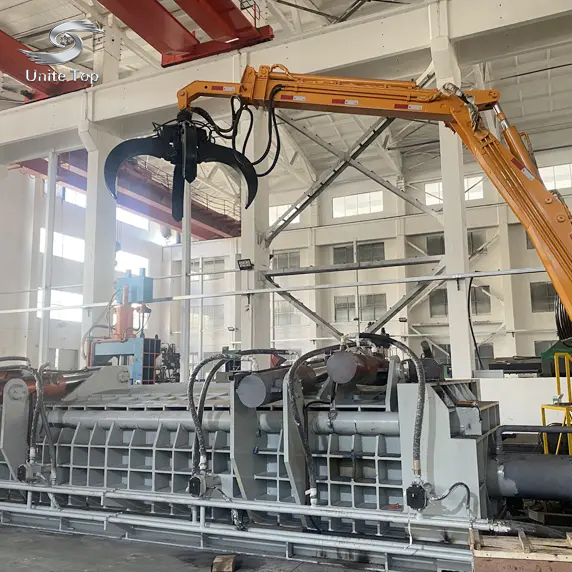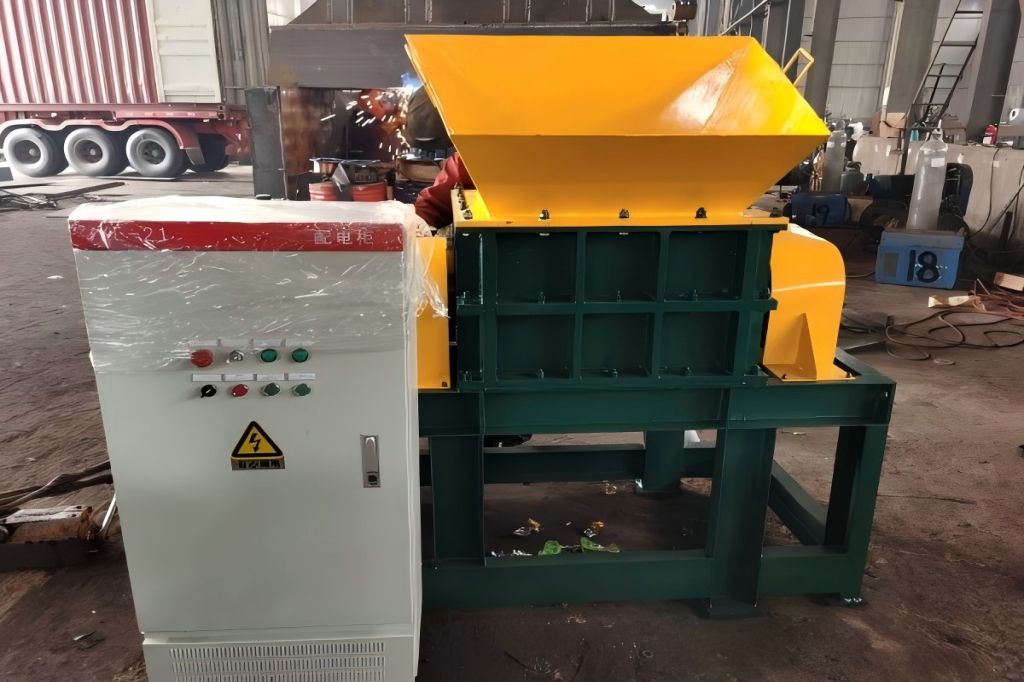Scrap metal processing is rapidly expanding as demand for recycled steel and aluminum grows. From dismantling yards to large recycling plants, operators aim to boost throughput, cut transport costs, and increase profits. The key question is: which equipment offers better ROI—a car baler or a metal shredder?
Both are essential, but they differ greatly in performance, investment, and operating costs. Shredders suit high-volume operations, while modern car balers deliver efficient, low-cost, high-density processing ideal for small and medium scrap yards.
This article compares both machines across function, capacity, cost, and profitability, showing that car balers often provide a faster and more accessible path to profit, especially for ELV and light-scrap processors.
Overview of Car Balers

What Is a Car Baler?
A car baler is a hydraulic device used to compress automobiles, light scrap, and mixed metal debris into bales with a high density. By reducing scrap volume by up to 80–90%, car balers dramatically lower transportation cost, increase storage efficiency, and speed up the scrap handling workflow.
Modern balers include multiple configurations:
- Mobile car balers: built on trailers or tracks, able to work directly at scrapyards or demolition sites.
- Stationary balers: permanently installed with larger chambers and higher pressure for continuous operation.
- Shear balers: combine baling and cutting functions to process oversized scrap.
- Door-less or lid-style balers: designed for faster cycle times.
A car baler’s purpose is simple: compact scrap into high-density blocks that maximize weight transport efficiency and selling price.
Key Components
A typical car baler includes:
- Compression chamber: The main body where vehicles and bulky scrap are compacted.
- Hydraulic cylinders: Provide the force needed to crush and compress scrap into briquettes.
- Main pump & hydraulic power unit: Controls pressure, speed, and baling force.
- Control system (PLC or panel): Ensures consistent pressure, cycle operation, and safety.
- Feeding area and bale discharge system: Allows vehicles and scrap to be loaded and removed efficiently.
Advanced models use intelligent hydraulic systems for faster cycles and low energy consumption, making them highly efficient even in small yards.
Typical Output & Applications
Car balers process:
- ELVs (end-of-life vehicles)
- Light steel scrap
- Aluminum scrap
- Household appliances
- Pressed profiles
- Mixed scrap
Output is delivered in:
- High-density bales
- Weight range from 200–1,200 kg per bale
- Density optimized for container or truck loading
Car balers are widely used in:
- Small and medium recycling yards
- Vehicle dismantling centers
- Scrap collection and sorting stations
- Local metal recovery businesses
- Mobile demolition projects
Because of their versatility and relatively low cost, balers are often considered the most profitable entry-level scrap processing machines.
Overview of Metal Shredders

What Is a Metal Shredder?
A metal shredder is a heavy machine designed to tear, cut, or smash scrap material into smaller pieces through mechanical forces. Unlike balers, shredders do not compress the scrap; they fragment it into uniform sizes to meet the feedstock requirements of large steel mills and recycling plants.
Common shredder types include:
- Single-shaft shredder: slow-speed, suitable for light scrap.
- Dual-shaft shredder: for mixed metal and tougher materials.
- Four-shaft shredder: offers controlled particle size.
- Hammer mill shredder: the most powerful, capable of shredding full cars in seconds.
While shredders deliver highly marketable output, they require large investments, significant space, and high power consumption.
Key Components
A typical shredding system includes:
- Rotor or hammer mill: The core of the machine that breaks down scrap.
- Cutting blades/hammers: Wear parts that require regular replacement.
- Conveyors for feeding: Move the scrap into the shredder area.
- Magnetic separation and classification system: Separates metals and removes impurities.
- Vibration screens or air separation: Ensures uniform particle size.
- PLC control platform: For safety and shredded size consistency.
Because of the complexity of these systems, shredders require high initial investments, a large power supply, and professional maintenance.
Typical Output & Applications
Shredders produce:
- Shredded scrap particles sized 50–150 mm
- Cleaned and sorted ferrous/non-ferrous materials
- High-purity output suitable for steel mill furnaces
Applications include:
- Automotive recycling centers
- Industrial scrap processing plants
- Large-scale material recovery facilities
- Aluminum fragmenting
- E-waste processing
Shredders are designed primarily for high-volume operations where continuous flow is required.
Performance Comparison: Car Baler vs. Metal Shredder
Processing Capacity
| Equipment | Typical Processing Capacity |
| Car Baler | 10–40 tons per hour (depending on model) |
| Hammermill Shredder | 30–200+ tons per hour |
| Dual-shaft Shredder | 5–25 tons per hour |
Shredders outperform balers in terms of hourly capacity, but the required investment is substantially higher. For most scrapyards, real-world volume makes a mid-range car baler more than sufficient.
Material Compatibility
Car balers excel at:
- ELVs
- Household appliances
- Aluminum
- Light steel
- Mixed scrap
Metal shredders excel at:
- Heavy steel
- Engine blocks
- Large car bodies
- Industrial waste
- High-volume continuous scrap
Balers offer broad flexibility without requiring complex separation systems.
Finished Product Value
Bales and shredded scrap differ in market value, but bales often provide a better price-to-production-cost ratio for medium-scale operators.
| Output Type | Density / Size | Market Value | Transport Efficiency |
| Bale (Car Baler) | 700–1,200 kg/m³ | Medium–High | Excellent |
| Shredded Scrap | 50–150 mm | High | Good |
Although shredded scrap can reach a higher selling price per ton, the operational cost of producing it is significantly higher. For many small and mid-sized facilities, baled scrap actually offers higher net profit.
Cost Comparison
Equipment Purchase Cost
Car balers:
- Mobile models: low to medium investment
- Shear balers: medium to high investment
- Overall accessible for small and mid-sized businesses
Metal shredders:
- High investment
- Hammermill shredders can reach multi-million-dollar budgets
- Additional cost for separation systems, conveyors, dust control equipment
- Car balers offer significantly lower barriers to entry.
Installation & Space Requirements
Car balers:
- Minimal civil engineering
- Can be installed outdoors
- Mobile models require no foundation
Metal shredders:
- Require large concrete foundations
- Need dust control systems
- Require industrial electrical power supply
- Need wide operational space
Operating Cost
| Cost Category | Car Baler | Metal Shredder |
| Electricity Usage | Low–Medium | Very High |
| Wear Parts | Low | High (hammers, screens) |
| Labor Requirement | Low | Medium–High |
| Maintenance Frequency | Moderate | High |
| Noise & Dust Control | Low | High |
The cost difference is one of the main reasons most scrapyards achieve profit faster through car balers.
Profitability Analysis: Which One Earns More Money?
Revenue Model of Car Baler
A car baler generates profit by:
- Producing high-density scrap—it increases saleable weight per truckload.
- Reducing transportation costs by 50–80%.
- Increasing yard capacity through compression.
- Handling ELVs quickly after dismantling valuable components.
- Delivering material suitable for export markets.
Because operating costs are low, even moderate scrap volume can generate strong profit margins.
Revenue Model of Metal Shredder
Shredders generate revenue through:
- High-throughput processing
- Producing furnace-ready shredded scrap
- Separating valuable metals such as copper, steel, and aluminum
- Selling high-purity output to steel mills
While the revenue per ton is higher, shredders require:
- High electricity cost
- Continuous feedstock supply
- Skilled labor
- Frequent hammer/blade changes
This makes shredders more suitable for large enterprises.
ROI Comparison (Example Calculation)
Assuming equal monthly scrap volume:
| Metric | Car Baler | Metal Shredder |
| Initial Investment | Low–Medium | Very High |
| Monthly Operating Cost | Low | High |
| Scrap Output Value | Medium–High | High |
| ROI Period | 6–18 months | 24–48+ months |
| Profit Stability | High (low risk) | Medium–High (high volume needed) |
For 80% of scrapyards, the car baler achieves a faster payback period and lower operational risk.
Suitability by Business Size & Scrap Type
Small & Medium Scrap Yards
Car balers are ideal for these businesses because:
- Investment cost is manageable
- Easy installation and operation
- Suitable for wide scrap variety
- Provides fast ROI
- Generates dense bales that sell well domestically and internationally
Small yards usually lack the consistent volume required to keep a shredder profitable.
Large Scrap Processing Plants
Large industrial processors may prefer shredders because they:
- Handle heavy scrap and car bodies continuously
- Produce steel-mill-ready output
- Integrate with automated separation lines
However, even large plants often use balers for:
- Pre-processing
- Compressing overflow scrap
- Export shipments
What Equipment Fits Your Scrap Type?
| Scrap Type | Best Machine |
| End-of-Life Vehicles | Car Baler |
| Mixed Light Scrap | Car Baler |
| Household Appliances | Car Baler |
| Heavy Industrial Scrap | Shredder |
| Volumetric Aluminum | Car Baler |
| Continuous High-Volume Scrap | Shredder |
For most medium-scale scrap sources, the car baler remains the more economical choice.
Case Studies / Comparative Scenarios
Case 1: Basic Scrapyard with Mixed Scrap
A 20-ton/day scrapyard installed a mobile car baler.
Results:
- 75% reduction in transportation cost
- 2× more scrap stored in the same yard area
- 12-month ROI
- Higher selling price for compacted bales
A shredder would have been oversized for the volume, creating unnecessary costs.
Case 2: ELV Vehicle Dismantling Center
A dismantling center processes 500–800 cars per month.
Baler benefits:
- Compresses stripped vehicles quickly
- Reduces manpower
- Improves loading efficiency
- Supports export bale shipping
This type of business gains significantly more from balers than shredders.
Case 3: Industrial-Scale Steel Recycling Plant
A large plant processes hundreds of tons per hour.
Shredder benefits:
- High output
- Clean steel fraction
- Direct furnace feedstock
Even here, a baler is still used for overflow scrap and inventory management.
Maintenance & Operational Considerations
Car Balers
- Simple daily checks on hydraulic oil
- Clean chamber and remove residue
- Inspect cylinders and hoses
- Low noise, low dust
- Minimal wear parts
Metal Shredders
- Regular hammer/blade replacement
- High vibration—requires frequent tightening
- Dust system maintenance
- Lubrication and screen cleaning
- Skilled technician required
Balers have significantly lower maintenance requirements, reducing downtime and cost.
Environmental & Regulatory Factors
Car balers produce minimal noise and dust, making them appropriate for urban scrapyards.
- Metal shredders must comply with:
- Noise regulations
- Dust control standards
- Environmental emission requirements
- Vibration control
Final Comparison Table: Car Baler vs Metal Shredder
| Factor | Car Baler | Metal Shredder |
| Investment Level | Low–Medium | High–Very High |
| Operating Cost | Low | High |
| Processing Capacity | Moderate | High |
| Scrap Type Suitability | Light/Mixed/ELV | Heavy/High-Volume |
| Installation Needs | Simple | Complex |
| Profitability | High (faster ROI) | High for large plants only |
| Risk Level | Low | Medium–High (volume dependent) |
| Best For | Small & Medium Scrap Yards | Large Industrial Recycling Plants |



